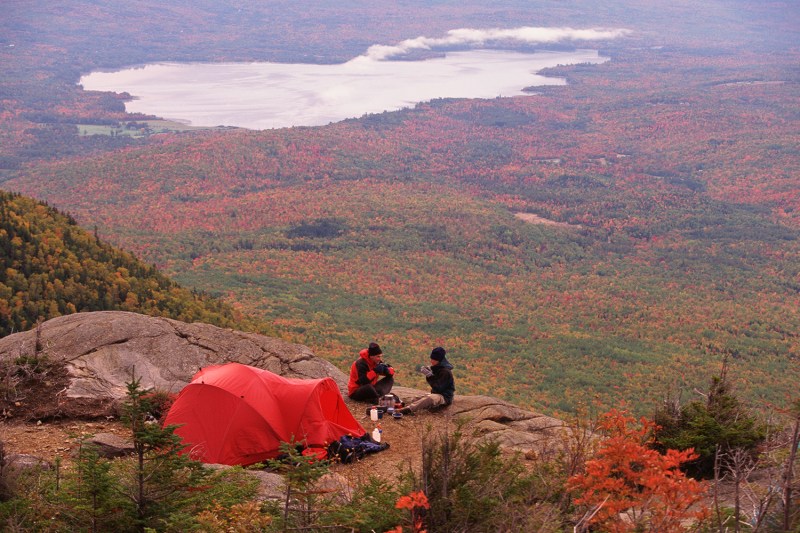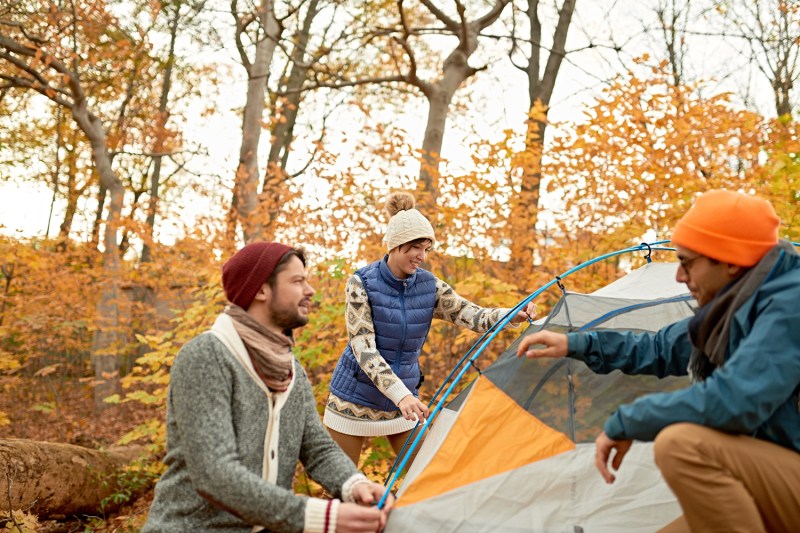Should you go camping in the fall? Well yeah, absolutely. What better way to experience the changing colors and falling leaves, those perfectly crisp morning temperatures, or the chilly nights that pair so well with a roaring campfire and whiskey in a mug?
With that being said, there are a few special considerations for fall camping that differ from the spring or summer trips you might be used to. Here are the fast-and-dirty facts you need to know if you’re planning to pitch a tent this fall season.
Related Guides
Pay Attention To The Weather

We like to think of the seasons like extended family members. Summer is that fun uncle with a boat and a lake house you can’t wait see every year. Winter is that grandmother that’s always knitting you something warm and telling you to eat more. And fall? Well, fall is that bipolar aunt that’s always full of, shall we say, “surprises.”
That’s a long-winded way of saying don’t assume you know what you never fully know — the weather. You can’t plan for a camping trip by simply stepping out your front door. That’s because fall is prone to big swings in temperatures, especially when you travel farther away from your home zip code or start gaining elevation. Keep an eye on the weather forecast and pack accordingly. For most of us, that means breaking out the merino wool socks, packing your favorite wool beanie, and piling on the layers. Speaking of which…
Bring All The Layers

When the temperatures start to drop, a good three-layer system really becomes important. If you’re considering going camping in the fall, your first step is packing the right clothing.
Base Layers
It all starts with the right base layers, and we recommend bringing both a long-sleeve top layer and a full-length bottom layer. Remember, anytime we’re going outdoors, we leave the cotton garments at home. That means those crusty old waffled thermals and long johns aren’t going to cut it, butt-flap or not. Your base layers should be made from either merino wool or synthetic fibers (typically a polyester blend), or even silk if you really wanna treat yourself (glampers, we’re looking at you). .
One of our favorite merino wool brands is Smartwool and its (Smartwool’s Intraknit series is tough to beat. Partial wool or synthetic blends are also a popular option, so just make sure the base layer you choose is a “middleweight” fabric, or something in the 200-250 weight range if you’re shopping wool.
Middle Layer
Once you’ve checked base layers off your list, we move on to the mid-layer. Your middle layer is the one that keeps you warm by retaining your natural body heat. The same basic rules apply here as far as fabrics go, so just go ahead and leave your favorite cotton hoodie or cotton “flannels” hanging in the closet. All those great wool sweaters you’ve been waiting to break out for the fall though? Pack those.
Patagonia is one of our favorite outdoor clothing brands. And that super cozy Patagonia fleece jacket? That’s the ticket. Then there’s always the tried-and-true puffy jacket. Puffy jackets come in different degrees of warmth, so while the super-thick alpine varieties are pretty much always overkill for the fall, puffy yet packable down jackets like the Mountain Hardwear Ghost Whisperer or synthetic versions like The North Face Thermoball will keep you comfortable day and night.
Outer Layer
Last but not least is your outer layer. This is the one that keeps the wind and rain at bay when the weather turns nasty. You won’t often need to wear an outer layer during the fall unless the wind is really whipping, but it’s better to pack one and not need it than need it and not have it. We prefer to stick with non-insulated softshell jackets like the Arcteryx Gamma LT as they’re more versatile for base and mid-layer systems such as this.
Related Reading: Best North Face Jacket Deals
Your Big-Ticket Three-Season Gear Might Not Be Enough
This one depends largely on the weather and location, but if you go camping in the fall, you need to be mindful of the limitations of your current gear. Specifically your sleeping bag and your camping tent.
Sleeping Bags: Three-season bags are built for spring, summer, and fall for most campers. However, we all know there isn’t a magic switch that turns fall temperatures into winter ones every year when December 21 rolls around. For that reason, you may need to consider a winter sleeping bag well before the seasons actually change.
Check the temperature rating on your current bag and compare it to the temperatures you’ll be sleeping in. You should see a range listed there, with a higher temp listed as the “comfort” rating, and a lower temp listed at a “limit” rating. If there’s any chance you’ll be sleeping in temperatures below your comfort rating, you’ll likely want to consider bringing a sleeping bag liner or upgrading to a winter bag (typically 20-degree or 0-degree F bags) instead.
Granted some sleep hotter than others, and there’s some variation between brands on how warm a “20-degree” bag actually sleeps, but don’t make the mistake of getting anywhere near your bag’s limit rating without a plan for extra warmth. Sleeping bags are rated based on the assumption that you’re using (a) a sleeping pad with an R-value of at least 4.0 and (b) those medium-weight base layers we talked about above. If you’re lacking either of those things, that “comfort” rated temperature feels a lot less comfortable.
Camping Tents: As far as shelters go, most campers shouldn’t need to switch to a four-season tent, but again, that all depends on the weather in your area. Your standard 3-season camping or backpacking tent (with the rainfly attached) should provide all the warmth you need when paired with the right sleep system and clothing. If you’re expecting anything beyond a light dusting of snow or temperatures well below freezing, however, you may want to consider stepping up to a four-season treeline model like the MSR Access.
Related Reading: Tent Buying Guide: Find the Best Tent for Your Trip
Editors' Recommendations
- These are the essential outdoor knots every outdoorsman should know
- 8 healthy benefits of hiking you need to know
- These are the best multi tools you need to have in your EDC kit, hands down
- These are the 8 sailing knots you need to know when out to sea
- I tried nearly all the Whistler and Banff hotels: Where you should stay when you go skiing and snowboarding




